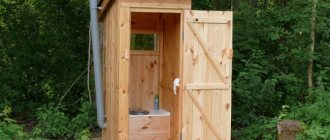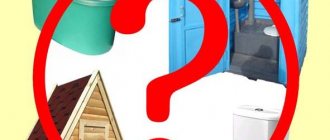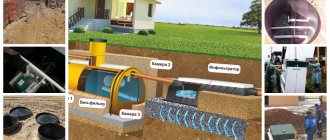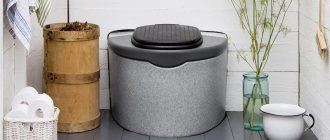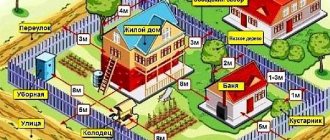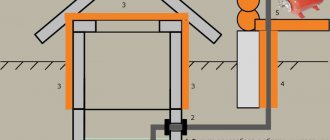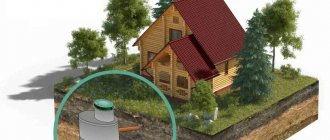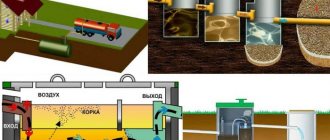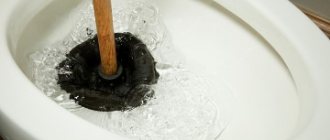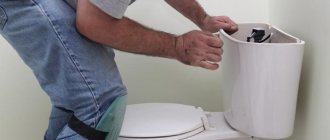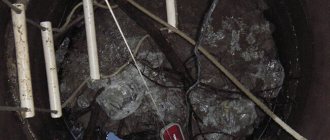A toilet on the site is the minimum living conditions in a country house or country house. When installing such a structure, the main difficulties arise with the cesspool. It accumulates waste that must be removed during operation.
But even if cleaning is carried out in a timely manner, during the heat the closet will emit unpleasant odors.
All this greatly overshadows the stay on the site. A practical solution could be a country toilet with an odorless pit cesspool. Our review will help you better understand all the design features, choose the right place for installation and choose the optimal toilet model.
Disadvantages of cesspools
Before you start making a country toilet, you should consider installing a cesspool - see options for building cesspools of different designs. A special tank is needed to collect waste. And to prevent the spread of odors, you will need a pit with a sealed bottom. But this option requires systematic pumping.
A good solution for a cesspool is to install a drainage bottom. The liquid will quickly be absorbed into the soil, and particles of the solid structure will settle. With significant accumulations of waste, siltation of the bottom may occur. And for such a case, special cleaning will be required. First, contaminants with solid waste are removed, and then the filter bottom is restored.
The following points should be noted among the disadvantages of a cesspool:
- To maintain and care for a country toilet, you will need financial investments. When the tank is full, pumping is necessary, carried out regularly.
- Even with high-quality sealing, you cannot protect yourself from the occurrence of an unpleasant odor in the country toilet.
- After some time, the walls begin to let in sewage and contaminate groundwater.
If a sewage system is installed at the dacha, it is necessary to come up with ways to insulate the container. In severe cold weather, sewage may freeze, which causes difficulties in using the system.
Tips and tricks for use
To ensure that your no-pump toilet is truly free of bad odors, it is important to keep it clean. Take out the filled powder closet container in a timely manner. After each cleaning, the tank is washed with water with the addition of antibacterial agents.
It is important to periodically check the operation of the ventilation. If there is not enough traction, the pipe protruding above the toilet roof is painted with black paint. Dark color attracts the sun's rays. The top of the pipe warms up faster, thereby increasing natural draft.
Caring for a septic tank is based on the timely introduction of bacteria. Depending on the installed equipment, its maintenance is performed. Single-chamber septic tanks in the country without connection to a filtration field require timely pumping of processed wastewater.
You can learn more about odorless toilet models from the video:
Requirements for the location of the cesspool and SanPin
Any construction is carried out taking into account special norms and rules of construction legislation. Since waste can cause soil contamination, certain requirements must be observed.
First of all, the bottom of the tank must be arranged with a slope in the direction of the hatch. To ensure tightness, it is necessary to create a tight connection of all surface elements. It is recommended to build a septic tank for accumulations from concrete rings. Additionally, a cover with an inspection hatch is expected.
To make an odorless country toilet with your own hands, read the following requirements:
- You cannot use containers that do not have a bottom.
- Sewage should not penetrate into the soil without preliminary cleaning.
- A residential building should not be located closer than 8-10 meters from the cesspool.
- The distance between water supply sources and the drainage system must be more than 50 meters.
- To eliminate odors in country toilets, disinfectant solutions are used - creolin, sodium hydrochloride or bleach.
Before installing a country toilet, you should plan the site. This diagram reflects the location of the house, the placement of utility networks and water supply sources.
general information
Scheme for constructing a toilet for a summer house and installing a cesspool without and with a bottom
. Having heard the phrase “a toilet in a private house without a sewerage system,” the owner imagines the work of digging a pit and building a reservoir for storing waste. The construction of such toilets is common and known since time immemorial.
You shouldn’t get hung up on this option; the modern construction market provides a choice of mechanisms that are also capable of working autonomously, but are relatively more comfortable.
We will look at the classic way to build a toilet, and innovative solutions in this area.
Construction of a cesspool
Cesspools can be sealed or not sealed, i.e. having no bottom. The last option is a tank, the walls of which protect the soil layers from the penetration of runoff. The bottom of the structure involves the use of a filter made of gravel and crushed stone. The advantage of the system is that there is no need for pumping with sewage disposal equipment - a suction pump.
It is not recommended to install a toilet for a summer residence without a solid bottom if groundwater is close to it. This will affect the filling of the tank during rain and will have a negative impact on the quality of filtration. Contaminated streams do not undergo purification, but immediately go into groundwater.
A hermetically sealed country toilet is a storage device. Waste is removed using pumping equipment. This option eliminates the release of bacteria and soil contamination.
The toilet in the country is made from the following materials:
- Tire structures are made without a special bottom. They are characterized by quick installation and low price.
- Concrete rings are a durable and reliable material. Lifting equipment is required to install them in the pit.
- You can quickly install a toilet from a barrel. It is suitable as a storage device. To install the filter you will need to remove the bottom.
Plastic models require additional fixation to the foundation. This will prevent it from floating during rainy periods. During backfilling, the tank must be filled with water to prevent deformation.
The design can be rectangular or round. The configuration should be selected taking into account the shape of the site. Concrete devices are made using formwork. Brickwork is done in a circle. When applying the methods, it is necessary to use a layer of waterproofing.
Digging a pit
The cesspool must have a depth of at least two meters. But the groundwater level must be below this mark. It is important to choose the right place to place the pit.
It should not be located on a slope of the site or away from the road. The hole is dug using an excavator or manually. Its width should be 50 centimeters wider than the intended container. This distance should be left for cladding. Additionally, you need to make trenches for the pipes.
Arrangement of the bottom of the sump
For a country toilet with a storage pit, a bottom filter is required. It is made from gravel and sand. You can also take crushed stone of certain fractions. A layer of sand is poured onto the bottom, and layers of gravel and crushed stone are placed on top.
Small elements should be located at the bottom, and large ones at the top. A concrete slab is laid on top of the embankment or a screed is made.
Arrangement of the internal part of the storage pit
To create an odorless toilet for your dacha with your own hands, you need not only to dig a pit, but also to finish the walls.
The following materials can be used for surface finishing:
- Concrete. The concrete solution is poured into pre-made formwork. The thickness of the layer should be at least 7 cm.
- Brick. Using red brick, the walls are laid out from the bottom to the very top.
- Rings. Laying reinforced concrete rings requires special equipment. The rings are laid out on a concrete base. The joints are treated with cement mortar.
After finishing the walls, the pit is connected to the sewer pipes. To create a tight seal, special rubber connectors are used. The outside of the pit is finished with clay or roofing felt.
The pit is covered with wooden logs and slate or a concrete slab. There must be a hole in the ceiling.
Making a wooden cabin
A wooden booth can be made from different materials - boards, profile sheets or bricks.
When arranging a cabin, ventilation and reliability are important parameters. The plank bathroom is especially popular. Wooden frames can be easily rearranged to a convenient location. When choosing wood as a material, it is worth considering that it can easily crack when exposed to sunlight or become deformed from humidity.
Wood requires special processing and varnishing. After installing the walls and floor, you must perform the following steps:
- Door installation. Additionally, you can make a slot in the form of a window.
- Roof installation. A profile sheet, roofing felt or asbestos cement sheet is suitable for finishing the roof.
- Applying the finishing coat. You can use paint or varnish.
The metal version is also popular. The metal or wooden frame is upholstered with profile sheets and secured with screws. We invite you to read the step-by-step instructions on how to build a wooden toilet stall with your own hands.
An important point is ventilation. This system is designed to remove unpleasant odors from the country toilet. A pipe is used to provide ventilation.
Installation of the cabin on the pit
Advice! It is important to choose a suitable foundation. A practical solution would be a tape-type base.
To build it, a minimum of excavation work and a small amount of cement are required. Moreover, such a foundation ensures stability on any type of foundation. For light houses, a foundation on pillars is suitable.
The concrete curb is installed at a distance of no more than 0.2 meters from the edge of the pit. Roofing material is laid on top of the base in several layers. The floor is made of thick boards, the thickness of which is at least 4 cm.
Find out how to choose a toilet for a country toilet - what models there are, how to install them or how to make a toilet seat yourself.
Instead of an afterword
It doesn’t matter which option of a country toilet without pumping and odor is chosen for use. And it doesn’t matter whether it is made with your own hands or in a factory. The most important thing is that he performs all the functions and tasks assigned to him. Well, the frequency of maintenance, installation location and the use of special mixtures and liquids (as well as their composition) is a personal matter for everyone. And therefore there can be no advice on this matter.
Do-it-yourself peat toilet from an ordinary bucket
Still, some generalizations are worth making. For example, if there is no desire to install a toilet, or health status does not allow it, and besides, a person spends only the summer months at the dacha, the option of renting a plastic toilet stall can be very convenient. At the same time, its maintenance is also provided, i.e. pumping, washing, etc., up to 4 times a month.
If you want the pumping to be rare and the toilet to be permanent, it is worth considering a septic tank of two or three wells. Well, provided that it is used infrequently, a peat dry closet will be quite convenient, which can be installed both outdoors and indoors. In addition, it does not require pumping, and therefore no expenses for it.
How to remove odor from a country toilet
Now let's find out how to remove the smell from the country toilet. There are various effective techniques.
Ventilation features
Ventilation systems for country toilets are constructed from PVC pipes. It is attached to the surface of the wall of the building using clamps. Part of the pipe is placed under the hatch of the cesspool, and the upper element is located above the house. To prevent moisture from getting inside, a special cap is installed.
Additionally, to reduce the smell in the toilet in the country, a hole is made in the wall or closer to the floor.
Chemicals
Chemical compounds are actively used. The following types of drugs are recommended:
- Nitrate ones are considered the safest. Oxidizing agents contain active elements that help remove odors from country toilets.
- Ammonium agents are the most effective.
- Bleach is a budget option, but very toxic.
When coming into contact with such components, it is recommended to use gloves and a respirator. Such preparations make the mass from the cesspool unsuitable for fertilization. The advantage of the chemistry is that it can be added to the pit at different temperatures.
Folk remedies
When solving the problem of how to get rid of the smell in the toilet in the country, you can try natural remedies:
- Ash or sawdust can be added after each trip to the toilet.
- The cut grass is placed inside.
- Tomato tops and nettle grass absorb stench well.
The resulting compost is used as fertilizer.
Bioactive substances
Among modern means, bioactivators are actively used. These drugs are a concentrate with strains of biological bacteria. For better activity of microorganisms, moisture, a temperature above 0°C and special organic substances are required - learn all about bacteria for septic tanks and cesspools in this article.
Sanex, Micropan and Doctor Robik are especially popular. These products help destroy harmful microbes, neutralize waste and unpleasant odors. Bioactivators help reduce the volume of a cesspool over time. The products are sold in the form of powder, tablets and liquid.
When using biological agents, it is necessary to prevent chemicals from entering the pit. It is not recommended to use such drugs in late autumn or early spring.
Fillers with peat
If the question arises of how to remove the smell from a country toilet, you can try using peat. This material is suitable for processing waste into useful compost. Peat is able to absorb odors, loosen the mass and intensively process sewage.
The advantages of this method:
- Moisture absorption.
- Odor removal
- Preventing compression of mixtures.
- Safety in relation to the environment.
A peat dry closet can be an excellent alternative to bulky outdoor buildings.
A similar product is offered by companies such as Gera, Bio-Life and Agro-Balt. For proper functioning of the toilet, a compact container for collecting sewage is suitable. After visiting the bathroom, peat is poured into the tank. Purchased designs have a dusting function.
This container must be cleaned after 3-4 days. The waste is taken to a compost heap, where peat or soil is sprinkled on top. This option is ideal in areas with close groundwater flow.
When installing a peat toilet indoors, it is imperative to create a forced ventilation system.
Installation of septic tanks
If you visit your dacha regularly throughout the year, it is recommended to install a septic tank. The device contains sealed compartments. Overflow septic tanks consist of several chambers.
In the first compartment, separation into liquid and solid fractions is carried out. Then in the second and third compartments more fine cleaning is performed. From the last compartment, the purified liquid enters the filtration fields. Water passes through the drainage layer into the ground.
Septic tanks with biological filters are capable of deeper cleaning. After cleaning, the liquid is drained to a pre-selected location.
Treatment systems
This design is an expensive version of a septic tank with multi-stage cleaning. It contains ultrafiltration, which allows high-quality water purification, which allows it to be reused. To quickly process waste, ion exchange reagents are installed.
Types of indoor closets for summer cottages
The most popular types of country house toilets are:
- Plastic bucket-closet. Known as the easiest portable toilet for disabled and elderly people. It differs from a children's potty in the presence of a seat with a lid. Enterprising users of such a device place a durable disposable bag inside, which is thrown away immediately after bowel movement. But you can simply throw away the feces and clean the bucket toilet.
- Biotoilet based on microorganisms. This is an improved version of the previous device, which absorbs unpleasant odors, so it is used indoors. From time to time it is necessary to add special biomass with living bacteria that process sewage in a removable container. Recycled waste can be used as fertilizer.
- Peat toilet. Another improved version (non-portable), in which sewage is mixed with peat, then the liquid part goes into a special container or directly into the drain, and solid waste remains inside, it must be periodically disposed of or used as fertilizer. Virtually no odor. However, it is still recommended to provide ventilation. This option is also called the Finnish toilet Ekomatic, Piteco, Biolan.
- Portable toilet based on chemical reagents. Another option for a bucket toilet. However, here the sewage is processed by pouring a mixture of chemical reagents inside. It does not spread a stench, however, processed sewage is harmful to the environment, so it should not be poured onto the beds, but must be disposed of in a special way.
- Electric dry closet. Outwardly it resembles a portable version, however, this version of the indoor closet is not mobile and must be connected to communications: ventilation and electricity. In this unit, solids and liquids are separated, then the solid waste is dried and placed in a container, and the liquid flows into the sewer. Ideal if it is not possible to organize a full-fledged septic tank.
Of course, the best option, and the most expensive, would be to install a full-fledged bathroom in a country house. It requires the installation of utilities (water supply, a full-fledged sewerage system, electricity), the allocation of a separate heated room in the house for a bathroom, as well as plumbing fixtures (toilet, cistern).
Odorless toilet in the country: budget options
When deciding how to eliminate the smell in an outdoor toilet, it is worth considering budget dry toilets. This is a good option for a country house or cottage. Let's look at models from popular manufacturers.
Tandem
Model Tandem Compact - Eco-friendly dry closet with peat filling and a special fan. Inside is a container for collecting sewage with a volume of 60 liters. The polystyrene body is durable. It has transport handles. The weight of the structure is 12 kg.
Advantages:
- Can be used in a toilet stall in a country house or indoors in a residential building.
- To dispose of sewage, a special peat composition is used.
- The body is made of high strength plastic.
- The separator and storage container are made of low-density polyethylene.
The structure can be connected to a forced ventilation system.
Price 7.8 thousand rubles.
Thetford
The company's budget option is the Porta Potti Qube 145. Although the price is low, the toilet is made of high quality materials. The container can hold up to 12 liters of sewage.
Advantages:
- Durability and structural strength.
- Resistance to mechanical damage.
- Affordable price.
- Resistance to environmental factors.
A pressure relief valve is provided to allow flushing without splashing. The portable design is made of high quality materials.
Price 4,000 rubles.
Bioforce
The portable country toilet of this company is designed for a load of 120 kg. The structure can be taken on picnics and trips for camping, as it is lightweight. During operation, you need to use special tools.
Advantages:
- No odors.
- No additional ventilation required.
- Compact and lightweight.
- Easy to use.
The toilet can also operate at sub-zero temperatures. If there are long breaks in operation, the rubber elements must be treated with a special composition for storage.
The price of the model is 4.5 thousand rubles.
Piteco
Piteco 201 is a stationary toilet for a summer residence, with peat filler. This model is equipped with a large tank, and the body is made of high quality materials. This option is also used in unheated rooms.
Pros:
- Made from plastic with frost-resistant properties.
- To eliminate unpleasant odors, a special ventilation pipe is provided.
- Sprinkling of waste with peat is carried out by turning the handle.
The cost of the model is 8.9 thousand rubles.
Dometic 972
The Swedish brand offers a country toilet with compact dimensions. This option is suitable for a small house.
Advantages:
- Functional design with modern design.
- Splash-free drainage system.
- Push-button device for draining.
- Comfortable seating.
To dispose of waste, it is necessary to purchase special septic tanks.
Price 8800 rubles.
Toilet for a summer residence - buy or build? The issue is complex, but solvable
For many, construction, even something as small as building a restroom stall, becomes an impossible task. In this case, you can simply purchase a ready-made dry closet and install it inside the house. Naturally, it is desirable that it be in a separate room. We have already discussed their cost, and therefore it makes sense to understand which one is more convenient for indoor installation.
The most optimal would be an electric dry closet, the liquid from which can be easily removed to the street. Provided that two or three people use it, its reservoir is unlikely to fill up over the summer.
A peat toilet for a dacha, which can be purchased much cheaper, is also quite easy to use. Its factory version includes a peat tank with a handle. Those. After use, you just need to turn the handle one turn, and the required amount of filler is poured into the tank. Containers for sewage in such latrines can be different - it all depends on the number of people in the house.
Installation of individual sewerage to the septic tank
In any case, you need to understand that you won’t be able to buy a good toilet for your dacha cheaply, because... quality always costs money.
Important advice! To choose a really good factory-produced product, you need to pay attention to reviews, prices of biotoilets for your dacha and their characteristics. Only then can you choose the ideal option.
Design and principle of operation of a portable dry toilet
Portable toilet installation
When purchasing a dry closet for your home, the operating principle of any of the named varieties is based on the autonomous operation of the lower and upper parts. With proper operation and proper care, they will perform all the functions assigned to them.
The upper part is a toilet that is familiar to everyone. Next to it there can be a tank with a volume of up to 15-20 liters, which is filled with water for flushing or peat.
The lower tank acts as a storage tank in which recyclable waste accumulates. It is easily detached for emptying and mounted back. Clean water from the upper tank flushes impurities into the lower tank. In it, waste products, subjected to processing by utilizers, are deodorized and settle at the bottom.
When the lower part is full, it is detached and the waste, which does not have an unpleasant odor and is environmentally friendly, is easily disposed of. The tank just needs to be washed, wiped and put back.
Let's watch a video review of the portable version:
The dry closet can be supplemented with a pump, valves for regulating pressure, indicators for filling and emptying tanks, special technical pipes and adapters for connecting to ventilation systems, a septic tank or sewerage system.
Chemical dry toilets
Chemical dry toilets have many advantages
Judging by the name, the reader can guess that in these models the breakdown of feces is carried out thanks to special chemicals. Chemical dry toilets consist of two tanks:
- in the top there is a water tank and a flush pump;
- Waste is collected in the lower tank, and a chemical reagent is also placed there.
Structure of a chemical dry toilet
The toilet paper compartment is a nice addition that not every model can boast of.
Such dry toilets emit a minimum of unpleasant odors, are easy to transport, and operate autonomously. You can place a chemical dry closet not only in a specially designated room, but also inside your home.
The models differ from each other in the design of the flushing mechanism and the size of the reservoirs. There are three types of flushing device:
pump-action; piston; electric.
Types of pumps for chemical toilets
The electric option is the most difficult, since it cannot work autonomously and requires a constant power supply or batteries. The chemicals needed to process waste cannot be called harmless to the human body. However, a modern manufacturer is struggling with this drawback and is trying to produce less aggressive reagents.
Pouring reagents
Types of chemical reagents
Biological compounds act on waste due to the presence of living microorganisms. Of all the options, this is considered the most environmentally friendly and safe for humans. Fertilizers can be used without fear when burning waste in this way; there are no problems with disposal.
Chemical dry toilets are very convenient to use
Draining waste fluid
Portable dry toilets are small in size and weight
Transportation of a portable dry toilet
Ammonium fillers are in second place in terms of safety. Fertilizers from such toilets can be applied to the soil only in small quantities. The breakdown of waste in the tank of a dry closet with ammonium liquid occurs very quickly, due to which there is practically no unpleasant odor.
Formaldehyde fillers are the most harmful to humans and animals. They are used only if waste from the toilet is not used to fertilize the soil, but is disposed of immediately.
Dry toilet for a summer residence: subtleties of choice
The models of dry closets on sale are numerous and varied. It is easier to choose a suitable model based on the following criteria:
- Volume of storage (lower) section . An important parameter that determines the frequency of cleaning the unit. It is selected taking into account the number of people who will use it. If the device is purchased for one person, a dry toilet with a capacity of 10-15 liters is suitable. If there are three users, the lower 20 liter container will have to be cleaned every three days.
- Dimensions . Before purchasing, you need to decide whether a portable dry closet will be enough, or whether a more substantial device will be required (with the allocation of space in the house or an extension) .
- Convenience . The standard seat height is 40-45 cm. Before purchasing, make sure that the selected model is comfortable to use.
What is it and what types are there?
A dry toilet is a kind of toilet with a container located below, where human waste products fall. There they decompose or are neutralized under the influence of certain factors. Decomposition can occur using:
- Peat
- Special chemical compounds
- Electricity
Accordingly, dry toilets can be depending on the operating mechanism
- peat,
- chemical
- or electric.
Expert opinion
Kuznetsov Vasily Stepanovich
The dry closet is quite compact, which allows it to be installed inside a country house or even transported from place to place.
Let's take a closer look at each of the types of toilets.
Peat
A peat dry closet uses peat to absorb feces.
Most models are filled with it using a special dispenser, which is a kind of funnel. Peat is placed in the dispenser, and then its handle is rotated, alternately changing direction so that the substance evenly covers the bottom of the device’s container. The main advantage of toilets of this type is the low cost of their operation. 150 - 200 liters of peat can be bought for approximately 500 rubles. This volume of substance will last for a very long time - a year or even more. In addition, there is peat specifically designed for dry closets. It is impregnated with substances that help break down feces and absorb unpleasant odors. Such peat will cost a little more.
Spent peat removed from the toilet can be used as fertilizer in the garden - after all, during the absorption of feces by peat, the process of their aerobic mineralization occurs (in other words, they are partially converted into inorganic substances needed by plants). Before applying fertilizer to the soil, it is better to mix it with the soil. This will help avoid chemical burns to plants - human excrement can be dangerous for them.
However, peat dry closets also have a number of disadvantages:
- Peat does not completely absorb odor. If the toilet is located on the street or in a utility room, there is nothing wrong with that. But if it is located in a residential building, ventilation of the device’s container is required. To do this, a special plastic tube is taken out of the container and goes outside. However, even this is not able to completely eliminate the unpleasant odor.
- Peat is not able to absorb urine. Therefore, it is also necessary to drain it from the peat toilet. Or just don't pee in it.
Expert opinion
Kuznetsov Vasily Stepanovich
Some models of peat toilets have a separate container for collecting urine, which greatly simplifies their use. I recommend paying attention to them if you decide to buy this type of dry closet.
Chemical
In a chemical dry closet, waste is processed using special chemicals. For this purpose, devices of this type have not only a container for collecting waste products, but also a small tank for processing feces substances.
It is located at the top of the toilet and has a small electric pump (in cheaper versions, a manual pump) that supplies the reagent to the lower section.
Unlike peat, chemical reagents can also process urine. In addition, they eliminate unpleasant odors much better.
Not all waste digesters are good at controlling odors. Some do not eliminate them completely. Before purchasing a reagent, consult with the seller and find out how effective it is in this regard.
In terms of costs, a chemical toilet is not as economical as a peat toilet. A liter bottle of solvent costs an average of 500 rubles. It must be dissolved in water at the rate of 20 - 30 ml per 1-2 liters of water (this amount is enough for 2-3 flushes). Thus, the reagent will be enough for approximately 30-40 single uses, that is, 60-80 flushes. However, do not forget that the reagent is much better at fighting unpleasant odors and is able to process urine.
Electric
An electric composting toilet works by drying feces using electricity. As a result of processing, they turn into dry fractions. Urine is not processed. It is collected in a separate container provided in most devices. However, some toilets do not have it, which requires drainage of liquid waste.
An electric toilet wastes a lot of energy because the heating element reaches high temperatures. The device itself is also not cheap - prices start at 10,000 rubles. In addition, it is necessary to organize ventilation - after all, the smell is also not eliminated in any way.
As in the case of a peat dry toilet, waste from an electric one can be used as fertilizer by adding to compost.
